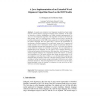107
Voted
ACL
2006
15 years 2 months ago
2006
We propose a novel bilingual topical admixture (BiTAM) formalism for word alignment in statistical machine translation. Under this formalism, the parallel sentence-pairs within a ...
130
Voted
ACL
2006
15 years 2 months ago
2006
This paper proposes a semi-supervised boosting approach to improve statistical word alignment with limited labeled data and large amounts of unlabeled data. The proposed approach ...
101
Voted
ACL
2006
15 years 2 months ago
2006
This paper proposes an approach to improve word alignment for languages with scarce resources using bilingual corpora of other language pairs. To perform word alignment between la...
112
click to vote
ACL
2004
15 years 2 months ago
2004
Aligning words from sentences which are mutual translations is an important problem in different settings, such as bilingual terminology extraction, Machine Translation, or projec...
109
Voted
NIPS
2007
15 years 2 months ago
2007
We present a novel paradigm for statistical machine translation (SMT), based on a joint modeling of word alignment and the topical aspects underlying bilingual document-pairs, via...
106
Voted
LREC
2008
15 years 2 months ago
2008
Parallel corpora are critical resources for machine translation research and development since parallel corpora contain translation equivalences of various granularities. Manual a...
86
Voted
LREC
2008
15 years 2 months ago
2008
For a language pair such as Chinese and Korean that belong to entirely different language families in terms of typology and genealogy, finding the correspondences is quite obscure...
85
Voted
LREC
2008
15 years 2 months ago
2008
This paper reports an experience on producing manual word alignments over six different language pairs (all combinations between Portuguese, English, French and Spanish) (Grac
127
Voted
IICAI
2007
15 years 2 months ago
2007
In recent years statistical word alignment models have been widely used for various Natural Language Processing (NLP) problems. In this paper we describe a platform independent and...
94
Voted
EMNLP
2007
15 years 2 months ago
2007
Word alignment is the problem of annotating parallel text with translational correspondence. Previous generative word alignment models have made structural assumptions such as the...





